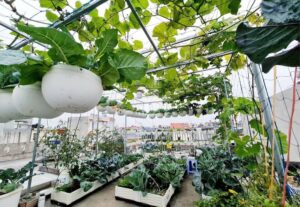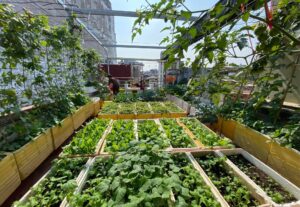Blog
“How to grow vegetables in the clouds”
Growing vegetables on clouds might seem like a concept straight out of science fiction, but with advances in technology and innovative farming techniques, it’s becoming an exciting possibility. In this guide, we’ll explore the steps and considerations for cultivating vegetables in the sky, offering practical advice and creative solutions to make cloud farming a reality.
Understanding Cloud Farming
Cloud farming, also known as atmospheric agriculture, involves growing plants in an environment suspended in the sky. This concept leverages advanced technologies such as aeroponics, hydroponics, and controlled environment agriculture (CEA) to create a suitable habitat for plant growth without traditional soil. The primary advantage of cloud farming is its potential to utilize vertical space and reduce land use, which can be particularly beneficial in densely populated urban areas.
Link Domain https://javanet247.com/
1. Designing the Cloud Farming System
To start growing vegetables on clouds, you need to design a cloud farming system that can support plant life. Here are the key components:

A. Floating Platforms
Floating platforms are essential for supporting plant growth in the sky. These platforms can be constructed using lightweight, durable materials that can withstand various weather conditions. The design should include:
- Sturdy Framework: Ensure the platform has a strong, stable framework to hold the growing medium and plants.
- Weather Protection: Incorporate features like weather-resistant coatings and shields to protect the plants from extreme conditions.
- Accessibility: Design the platform for easy maintenance and harvesting. Consider incorporating retractable or foldable features for convenience.
B. Nutrient Delivery System
Since traditional soil is not used, a nutrient delivery system is crucial for providing plants with essential nutrients. Options include:
- Hydroponics: Grow plants in a nutrient-rich water solution, using a system of tubes and pumps to deliver nutrients.
- Aeroponics: Suspend plants in air and mist their roots with a nutrient solution. This method provides excellent oxygenation and nutrient absorption.
- Nutrient-Film Technique (NFT): Use a thin film of nutrient solution flowing over the plant roots, providing constant access to nutrients.
C. Environmental Control
Controlling the environment on a floating platform is essential for healthy plant growth. Key factors to manage include:
- Temperature: Maintain optimal temperatures for different vegetable varieties using heating or cooling systems.
- Humidity: Control humidity levels to prevent diseases and ensure proper plant development. Use dehumidifiers or misting systems as needed.
- Light: Provide artificial lighting if natural sunlight is insufficient. LED grow lights are energy-efficient and can be adjusted to mimic sunlight.
2. Choosing Vegetables for Cloud Farming

Not all vegetables are suited for cloud farming. Select varieties that thrive in controlled environments and have relatively short growth cycles. Some ideal options include:
- Leafy Greens: Lettuce, spinach, and kale are well-suited for hydroponic and aeroponic systems. They grow quickly and require less space.
- Herbs: Basil, mint, and cilantro adapt well to vertical farming systems and can add value to your cloud farm.
- Radishes: Fast-growing and compact, radishes are an excellent choice for cloud farming systems with limited space.
3. Setting Up the Cloud Farming System
Once you have your design and vegetable selection, follow these steps to set up your cloud farming system:
A. Build or Install Floating Platforms
Construct or install the floating platforms according to your design specifications. Ensure they are securely anchored and capable of supporting the weight of the plants and growing medium.
B. Install the Nutrient Delivery System
Set up the hydroponic or aeroponic system on the platforms. Connect the nutrient solution reservoirs to the delivery system, and test the flow rates and nutrient levels to ensure they meet the needs of your chosen vegetables.
C. Implement Environmental Controls
Install temperature, humidity, and light control systems. Calibrate these systems to maintain optimal growing conditions for your vegetables. Regularly monitor and adjust settings as needed.
4. Monitoring and Maintenance

Regular monitoring and maintenance are crucial for successful cloud farming. Here’s what to focus on:
A. Check Plant Health
Regularly inspect plants for signs of pests, diseases, or nutrient deficiencies. Address any issues promptly to prevent damage and ensure healthy growth.
B. Maintain the Nutrient Delivery System
Monitor the nutrient levels in the solution and refill or adjust as necessary. Clean and inspect the system regularly to prevent clogs or malfunctions.
C. Adjust Environmental Conditions
Continuously monitor temperature, humidity, and light levels. Make adjustments to maintain optimal conditions and address any fluctuations that could impact plant growth.
5. Harvesting and Yield
Harvest your vegetables once they reach maturity. The timing will depend on the specific varieties you are growing. Use proper techniques to ensure a clean and efficient harvest, and consider implementing a system for collecting and storing produce.
6. Future Prospects and Innovations
Cloud farming is still an emerging field with exciting potential for growth and innovation. As technology advances, we can expect improvements in floating platform designs, nutrient delivery systems, and environmental controls. Additionally, integrating renewable energy sources and exploring new growing techniques will further enhance the sustainability and efficiency of cloud farming.
External link: art.htmlhttps:/jetluxury.techarmz.com/transformed-celebrity-
Conclusion
Growing vegetables on clouds is an innovative and promising approach to agriculture, offering a solution to land scarcity and urban farming challenges. By designing an effective cloud farming system, selecting appropriate vegetables, and implementing rigorous monitoring and maintenance practices, you can successfully cultivate fresh produce high above the ground. As technology and techniques continue to evolve, cloud farming could become a key component of sustainable food production in the future.
Whether you’re a visionary farmer or a curious enthusiast, exploring the possibilities of cloud farming opens up a world of opportunities for advancing agriculture and harnessing the power of the sky.

